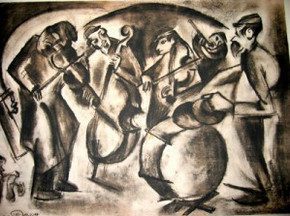
Jewish musical folklore: from origins through centuries
Contents
 The Jewish people, one of the oldest civilizations, is rich in a great heritage. We are talking about folk art that clearly illustrates pictures of everyday life, traditions and customs of the Israelis.
The Jewish people, one of the oldest civilizations, is rich in a great heritage. We are talking about folk art that clearly illustrates pictures of everyday life, traditions and customs of the Israelis.
This unique expression of the genuine folk spirit gave rise to many dances, songs, tales, anecdotes, proverbs and sayings, which to this day are the objects of heated historical discussions.
The most ancient musical origins: psalms to the accompaniment of the psalter
Jewish folklore was initially directly related to religion, and the periods of the reign of Kings Solomon and David contributed to its rapid development. History knows the psalms composed by David himself and performed by him to the sounds of the harp (or psalter, as it was called in those days).
Through the efforts of David, temple music became widespread, performed by Levitical priests who formed a church choir that numbered at least 150 people. Even in war they had to sing songs while performing in front of the troops.
The decline of Jewish folklore was largely influenced by the fall of the Kingdom of Judah and, as a consequence, the influence of neighboring peoples. However, by that time it was so developed that today the oldest motifs of Jewish singing are widely known in Israel and are predominantly minor melodies, rich in coloratura. The constant, oppressive influence on Jewish folklore did not deprive it of its extraordinary originality.
Ancient Jewish singing has 25 musical notes, each of which, unlike our notes, denotes several sounds simultaneously. The “king” sign confidently entered into musical terminology under the name “gruppetto” – often found in melisma scores.
Music in the life of Israelis
Jews accompanied all important events in life with songs: weddings, the victorious return of troops from war, the birth of a child, funerals. One of the brightest representatives of Jewish folklore were klezmers, who mainly performed at weddings with 3-5 violinists. Their songs were not related to worship and were performed in a very unique form.
One of the widely known songs praising life and all things is considered to be HavaNagila, written in 1918 based on an ancient Hasidic melody. The world owes its creation to the collector of Jewish folklore Abraham Ts. Idelson. It is noteworthy that, although considered the brightest element of Jewish folk art, the song is not such, although its popularity among Israelis is amazing, so the origins and reasons for the emergence of the song are currently the subject of active debate. The modern version is slightly different from the original version.
Jewish songs are colorful, they capture attention with their traditional oriental sharp and intense harmony, formed over many centuries, containing the full depth of historical events through which, in spite of everything, the Israelis went through with amazing resilience and love of life, establishing themselves as great nation.





